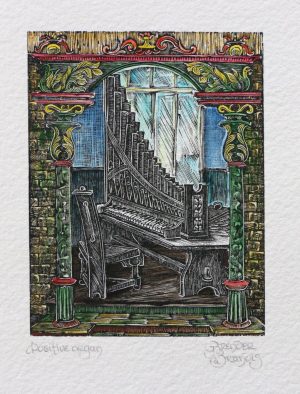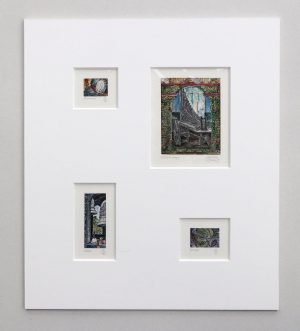La version française suit
By Vanessa Di Francesco, Assistant Curator, McGill Visual Arts Collection

Figure 1: Gerard Brender à Brandis, Rebec, from the series Concord of Sweet Sounds: Musical Instruments in Shakespeare, 2006-2009, hand-tinted wood engraving, 6 x 7 cm. Visual Arts Collection, McGill University Library 2018-020.22. Photo Davin Luce
Tiny is trending, big time. From micro-homes and minimalist design to microbreweries and small-batch production, the downsizing wave is cresting. But tiny has always been trendy, especially in art. For centuries, artists and artisans have been creating miniature masterpieces that astonish in their careful attention to detail and engage a close, even intimate viewership. You cannot glimpse in passing at a tiny picture. The famous, intricately painted miniature portraits of the early modern period, for example, beg to be looked at up close and examined, to be picked up and measured against one’s hand.
A more recent example of this miniature tradition in art, printmaker Gerard Brender à Brandis’ series, Concord of Sweet Sounds: Musical Instruments in Shakespeare, includes 24 meticulously hand-tinted wood engravings that are often no bigger than a Canadian loonie (Figure 1). Each engraving depicts one of dozens of instruments alluded to in Shakespeare’s plays and poems. The series of tiny prints was also the subject of a short book, with the same title, featuring text by F. David Hoeniger, Professor Emeritus of English at Victoria College, University of Toronto.[1] McGill’s Visual Arts Collection recently acquired the series by way of a generous gift from the Collection of Freda and Irwin Browns.

Figure 2: Gerard Brender à Brandis, Positive Organ, from the series Concord of Sweet Sounds: Musical Instruments in Shakespeare, 2006-2009, hand-tinted wood engraving, 13 x 10.5 cm. Visual Arts Collection, McGill University Library 2018-020.14. Photo Davin Luce
Brender à Brandis’ pictures are fine in every sense: small and delicate, they are almost jewel-like in their precision, intense colouring, and rich texture, revealing the work of a skilled and steady hand. The artist, born in Holland, and based in Stratford, Ontario, is one of few wood engravers working in Canada today. A member of the Wood Engravers’ Network, Brender à Brandis studied at McMaster University and honed his practice by traveling Europe and visiting master engravers. Most of his work, examples of which can be found in collections throughout North America, is rendered on a small-scale. In fact, tiny is a way of life for the artist, whose home and studio, a popular tourist destination in Stratford, is affectionately described as “so small” that it can only accommodate a few people at a time.
There is something especially enchanting about representing in miniature something monumental: the engraving of the organ (Figure 2), whose big sounds Shakespeare referred to in The Tempest as “deep and dreadful,”[2] is perhaps the most detailed work in the series. Even here, though, the artist has “downsized,” choosing to represent the smaller, one-manual pipe organ (or “positive organ”) that would have been familiar in Shakespeare’s time. To consider each print in the series is also to consider in this way the relationship between music, literature, history, and art, making the series uniquely appropriate for a University collection.

Figure 3: Gerard Brender à Brandis, Tambourine, Positive Organ, Bells, and Hornpipe, from the series Concord of Sweet Sounds: Musical Instruments in Shakespeare, 2006-2009, hand-tinted wood engravings, 40 x 35 cm (mat). Visual Arts Collection, McGill University Library 2018-020.13-020.16. Photo Davin Luce
As an example, especially, of the strong and storied relationship between music and art, the series also speaks to the continued collaboration between McGill’s Visual Arts Collection and the Schulich School of Music, where the prints, beautifully matted (Figure 3) and framed, will soon be on display. Another collaboration between the two units is anticipated for spring 2019 during Montreal’s annual Nuit Blanche. As with last year, an art and architecture tour of historic Redpath Hall will be followed by a performance on McGill’s celebrated (and not so tiny) French classical organ. Stay tuned on the Visual Arts Collection’s website for more information!
[1] Gerard Brender à Brandis and F. David Hoeniger, Concord of Sweet Sounds: Musical Instruments in Shakespeare (Erin, Ontario: Porcupine’s Quill, 2009). A copy is available in the McGill University Library.
[2] See pgs. 54-55 of Brender à Brandis and Hoeniger for the representation of the organ in Shakespeare’s works.
Et toute petite qu’elle est, elle est féroce : Gravures d’instruments de musique dans l’œuvre de Shakespeare par Gerard Brender à Brandis
Par Vanessa Di Francesco, conservatrice adjointe, Collection des arts visuels de l’Université McGill

Figure 1: Gerard Brender à Brandis, Rebec, tiré de la série Concord of Sweet Sounds: Musical Instruments in Shakespeare, 2006-2009, gravure sur bois teinte à la main, 6 x 7 cm. Collection d’arts visuels, Bibliothèque de l’Université McGill. 2018-020.22. Photo Davin Luce
Le minuscule se taille une place énorme dans les tendances. De la minimaison au design minimaliste en passant par les microbrasseries et la production en petits lots, la vague de la réduction atteint une crête. Cela dit, le minuscule est une tendance qui persiste, et ce, surtout dans le domaine des arts. Depuis des siècles, artistes et artisans créent des chefs-d’œuvre miniatures stupéfiants par l’attention soignée portée à leurs détails qui appelle une observation rapprochée, voire intime. Impossible de jeter un œil rapide à une image minuscule plutôt que de se livrer à un examen minutieux. Ainsi, les fameux portraits miniatures à la facture complexe du début de la période moderne demeurent dans l’attente d’un examen rapproché, de leur manipulation et de leur comparaison avec la taille de la main de l’observateur.
Plus près de nous, la série Concord of Sweet Sounds: Musical Instruments in Shakespeare du graveur Gerard Brender à Brandis comprend 24 gravures en bois méticuleusement teintées à la main qui, bien souvent, ne dépassent pas la taille du huard canadien (Figure 1). Chaque gravure dépeint un instrument parmi les douzaines évoqués dans les pièces et les poèmes de Shakespeare. De plus, cette série a inspiré un court ouvrage éponyme de F. David Hoeniger, professeur d’anglais émérite au Collège Victoria de l’Université de Toronto[1]. Grâce à un don généreux de la Collection de Freda et Irwin Browns, la Collection des arts visuels de McGill a acquis cette série dernièrement.

Figure 2 : Gerard Brender à Brandis, Orgue positif, tiré de la série Concord of Sweet Sounds: Musical Instruments in Shakespeare, 2006-2009, gravure sur bois teinte à la main, 13 x 10,5 cm. Collection d’arts visuels, Bibliothèque de l’Université McGill. 2018-020.14. Photo Davin Luce
Les images de Brender à Brandis expriment la finesse dans toutes leurs facettes : petites et délicates, elles atteignent presque la précision d’un travail d’orfèvre. Leurs couleurs intenses et leur riche texture dénotent le travail d’une main habile et stable. Né en Hollande et établi à Stratford, en Ontario, l’artiste est un des seuls graveurs sur bois en activité au Canada de nos jours. Membre du Wood Engravers’ Network, Brender à Brandis a étudié à l’Université McMaster et a affiné son art à l’occasion de voyages en Europe et de visites à des maîtres-graveurs. La plupart de ses œuvres, dont des exemples figurent dans des collections partout en Amérique du Nord, sont produites à petite échelle. L’artiste, qui a fait du minuscule un mode de vie, possède une maison-studio, destination touristique populaire à Stratford, décrite affectueusement comme étant « si minuscule », qu’elle ne peut accueillir que quelques personnes à la fois.
La représentation en miniature de quelque chose de monumental suscite un enchantement particulier : la gravure de l’orgue (Figure 2), dont Shakespeare a décrit le son puissant dans La Tempête comme étant « lourd et redoutable[2] » est peut-être la pièce la plus détaillée de la série. Cela dit, même dans ce cas, l’artiste a réduit l’ampleur pour représenter l’orgue manuel le plus petit et doté d’un seul clavier (« orgue positif ») qui eut été courant à l’époque de Shakespeare. Pour juger de chaque gravure de cette série, il faut tenir compte de la relation entre la musique, la littérature, l’histoire et l’art qui rend cette œuvre parfaitement indiquée pour une collection universitaire.

Figure 3: Gerard Brender à Brandis, Tambourin, Orgue positif, Cloches, et Hornpipe, tiré de la série Concord of Sweet Sounds: Musical Instruments in Shakespeare, 2006-2009, gravure sur bois teinte à la main, 40 x 35 cm (passe-partout). Collection d’arts visuels, Bibliothèque de l’Université McGill. 2018-020.13-020.16. Photo Davin Luce
À titre d’exemple, notamment, de la relation solide et documentée entre la musique et l’art, soulignons à propos de cette série la collaboration continuelle entre la Collection d’arts visuels de McGill et de l’École de musique Schulich, où les gravures, magnifiquement serties dans des passe-partout (Figure 3) et encadrées, seront bientôt exposées. Une autre collaboration entre les deux départements est prévue pour le printemps 2019 à l’occasion de la tenue annuelle de la Nuit blanche de Montréal. Tout comme ce fut le cas l’an dernier, une visite guidée mettant en vedette l’art et l’architecture de la salle historique Redpath sera suivie d’une prestation à l’orgue classique français (pas si petit que ça). Demeurez à l’affût des renseignements supplémentaires dans le site Web de la Collection des arts visuels!
[1] Gerard Brender à Brandis et F. David Hoeniger, Concord of Sweet Sounds: Musical Instruments in Shakespeare (Erin, Ontario: Porcupine’s Quill, 2009). Exemplaire disponible à la Bibliothèque de l’Université McGill.
[2] Consulter les pages 54 et 55 de la publication de Brender à Brandis et Hoeniger pour voir la représentation de l’orgue dans l’œuvre de Shakespeare.












Leave a Reply
You must be logged in to post a comment.